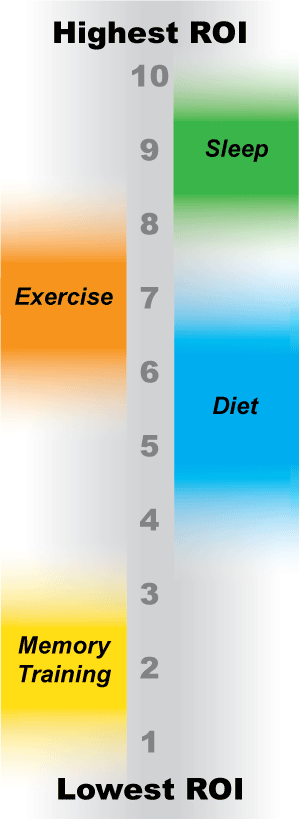| The amount of literature related to memory improvement is enormous and is generated by many different scientific disciplines. It may be impossible for any one person to know it all.However, here we will attempt to boil all of this information down into just four areas, and place them very roughly on a ten-point scale. Items close to 1 on this scale tend to provide the lowest return-on-investment, and items closer to 10 provide the highest benefit.This simple scale will show you where you can get the greatest “bang-for-the-buck” when trying to improve your memory. |
1. SleepCovering a range from 8 to 10 on this scale is sleep. Sleep will provide you with the highest return-on-investment when it comes to memory or memory improvement. However, sleep is not the same as time in bed. This sleep must be what researchers call restful or restorative sleep—7-9 hours of primarily uninterrupted sleep with full sets of what researchers used to call REM cycles. It is during these deep, restful cycles that memories are sorted, encoded, and placed into long-term memory. 2. ExerciseNext on this scale is exercise, ranging from roughly a 6 to around an 8. Exercise improves blood flow to the brain. Your brain cannot function well without it. But professional athletics is not necessary. Any movement that increases blood flow helps. Simply taking the stairs instead of the elevator, or walking around the block after a meal. Keep moving. Keep that blood flowing through the brain and you will be more likely to keep your memories. 3. DietI know you’ve heard the saying that you are what you eat. Well, eating the right things scores between 4 and 7 on this scale. You can boost your brain power by eating more foods with antioxidants and anti-inflammatory agents. Antioxidants capture free radicals that can damage brain cells. Dark-colored fruits and vegetables give you the biggest antioxidant bang for the buck. Avoid foods that trigger inflammatory responses, such as sugars, processed foods, alcohol and refined grains. Foods rich in omega-3 fatty acids, like fish and plant oils, counter inflammation that can damage healthy brain cells. 4. Memory Improvement ProgramsRounding out the bottom of this scale, from 1 to around 3, are commercial, memory improvement programs. Although many people do gain some benefit from “brain game” types of programs, their long-term affects have not been established. |
| So, if sleep, exercise, and diet can provide a higher return-on-investment when trying to improve your memory, why would you want to do anything like the Attention Workout or the ACTIVE Memory Works programs? Good question. Here are two points you should consider:
Clinical research has proven that the ACTIVE program can cause long-term memory improvement—and remain measurable a full ten years after intervention. In addition, the evidence indicates that those improvements translated into significant improvements in IADL’s, Independent Activities of Daily Living. Participants in the original ACTIVE Study were able to drive and live independently longer than participants in the control groups of this study. In addition, these beneficial affects appeared to persist in spite of normal, age-related changes to sleeping, exercise, and diet regimes. Bottom line, although the impact of benefits from programs like the ACTIVE Memory Works program may initially seem low, they can have a significant, statistical, and measurable impact on your memory health for many years into the future. The Journal of American Geriatrics Society said it best in 2014 when publishing the ACTIVE Study’s final 10-year results. Referring to the people who went through the ACTIVE program; they said… |
“After 10 years, 60% to 70% of participants were as well off as, or better off, than when they started.” |
|---|
